Business
Top Ten Free Chatbots: Empowering Businesses with AI-Powered Assistance
Published
2 years agoon
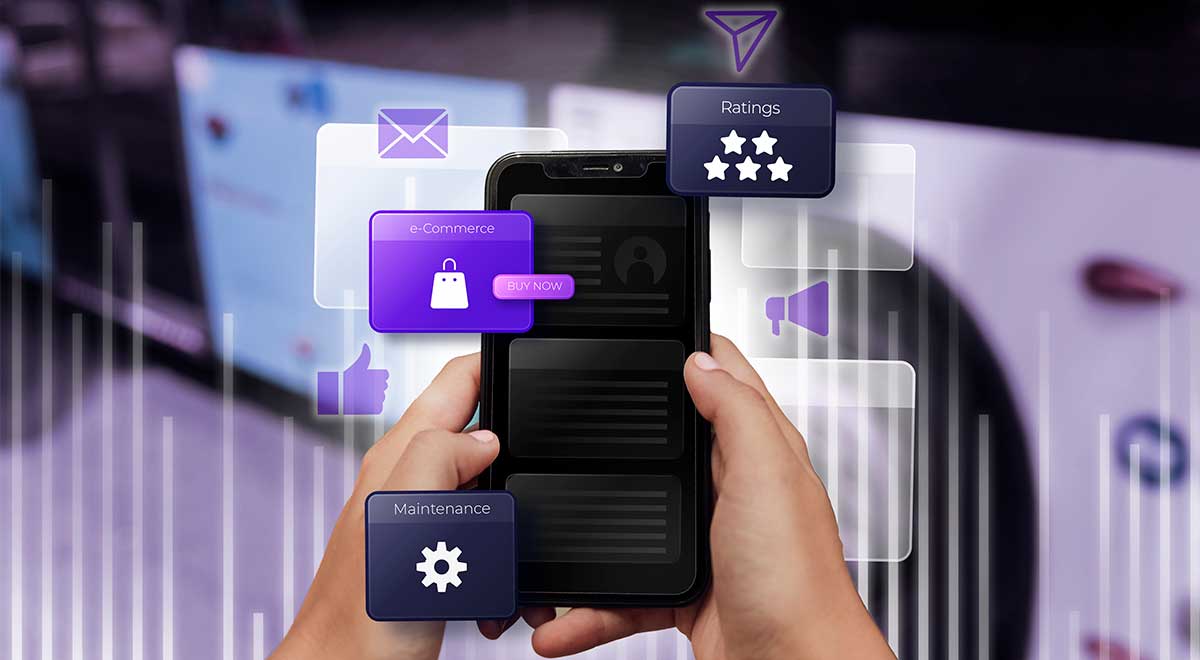
Artificial intelligence was once a figment of our imagination. We did not realize that it would change our lives in ways we coculd only imagine. It has become a massive part of our daily lives, from self-driving cars to disease diagnosis. Managing a business has also become easier, thanks to the technology. Here are the top ten free AI chatbots you can choose from to make your business operations more productive:
What is an AI Chatbot?
An AI chatbot is a computer program that uses artificial intelligence to communicate in a human-like conversation with users. Businesses use these to engage and respond to customer queries and provide information and assistance. AI chatbots offer instant and efficient customer support to improve the customer experience while saving you time, effort, and resources.
As promised, here is our list of the top free AI chatbots:
1. ChatGPT

One of the most popular chatbots known worldwide, ChatGPT can help businesses with customer support, lead generation, content creation, and many others. It can enhance customer engagement, automate processes, and improve your business’ operational efficiency.
To use ChatGPT for customer support, you can integrate it into your website or chat platforms through the necessary code or by embedding a chat widget. It also allows you to include an option for customers to transfer to human support when needed.
2. YouChat
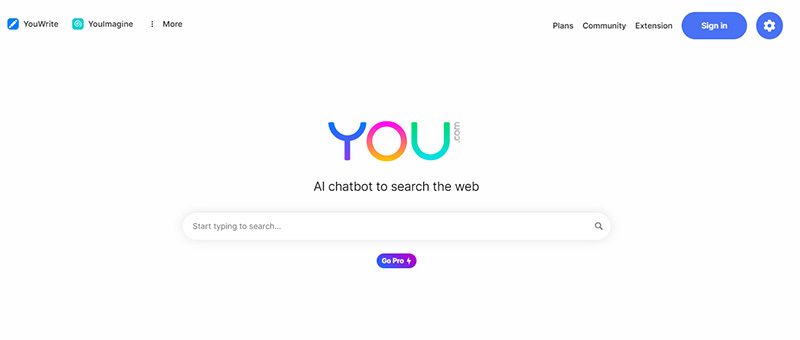
A powerful AI chatbot platform, YouChat offers various features to help businesses with customer engagement and support. With it, you can create personalized and interactive chatbot experiences, automate repetitive tasks, and provide round-the-clock customer support. It also gives valuable insights and multilingual support for a diverse customer base.
To effectively use YouChat, you need to integrate it into your website and customer support channels. Once you do this, you can customize the responses and train them to understand industry-specific terminology and customer questions.
3. Customers.ai
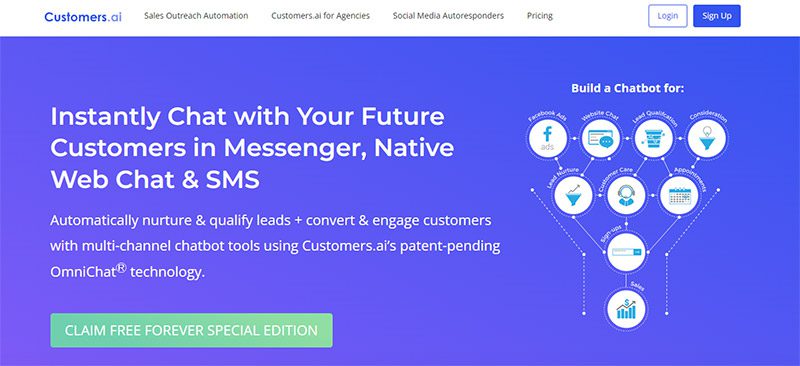
A versatile free AI chatbot platform, Customers.ai allows businesses to use the power of natural language processing (NLP) to handle their customers’ inquiries. The chatbot lets you create personalized responses and automate many routine tasks. It has incredible features like chat blasts, drip campaigns, and lead generation capabilities.
Customers.ai provides analytics and reporting that lets you measure the effectiveness of your chatbot interactions. From there, you can optimize your customer support strategies.
4. Perplexity AI
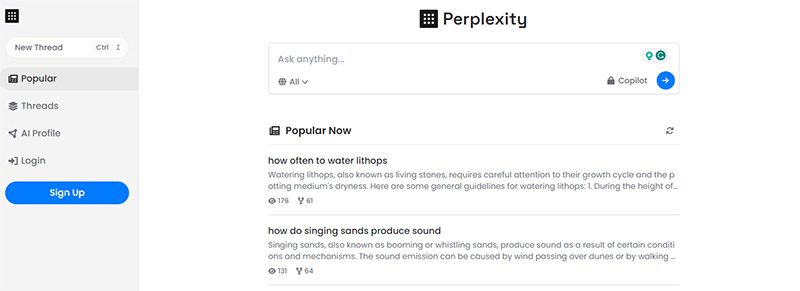
Develop intelligent chatbots for your business with Perplexity AI. It uses the power of NLP to let chatbots grasp the meanings of your customer messages to help you craft highly contextual and accurate responses. It offers excellent features such as sentiment analysis, intent recognition, and personalized customer support.
Like the free AI chatbots on this list, you can integrate Perplexity into your website to make it work for you. With this software, you can easily handle large volumes of inquiries, address FAQs, and guide customers on their sales journey.
5. Botpress
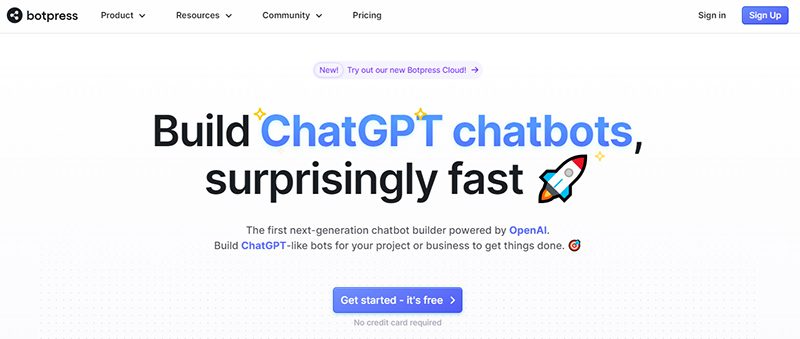
An open-source AI chatbot development platform, Botpress can help you streamline many of your business processes. It is a free AI chatbot that can understand and respond to your customers’ queries while automating many of your routine tasks. It offers an array of features such as dialogue management, entity extraction, and integration with your external systems.
With Botpress, you can revolutionize your customer interactions and support strategies. To do this, integrate the chatbot into your website, mobile apps, and messaging channels.
6. The New Bing
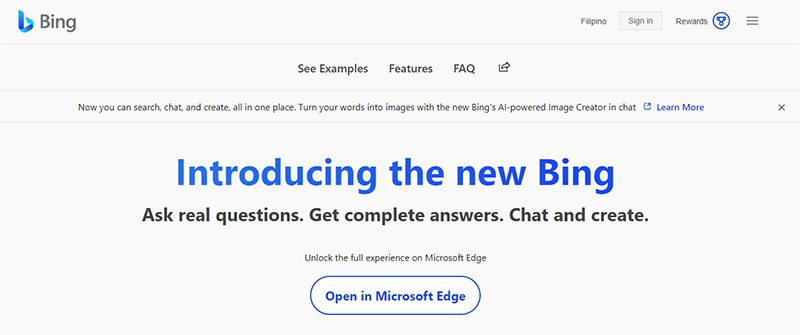
Another popular AI chatbot, The New Bing, can help your business automate customer service and support. With it, you can respond quickly and accurately to their inquiries, helping you save time and money. It can reply with personalized answers tailored to your customer’s specific needs.
You can use Bing when you integrate it into your website, mobile apps, and messaging platforms. Microsoft leverages Open AI’s ChatGPT capabilities into Bing to have it respond and have a human-like conversation with your customers.
7. Dialogflow

Developed by Google, Dialogflow is an impressive NLP that helps businesses build intelligent chatbots and virtual assistants. You can create interactive and context-aware chat experiences across multiple platforms, which include websites, messaging apps, and voice assistants, to name a few.
To have Dialogflow work for you, you must integrate it into your customer support channels. It offers features to help you develop your chatbot, including intent recognition, context management, and entity extraction.
8. Landbot.io

While not exactly an AI chatbot, Landbot.io can help you craft your own. Another chatbot development platform is Landbot.io which lets businesses create them even without technical expertise. It uses a visual builder that gives you a selection of customization options. It supports many media formats, including text, images, buttons, and videos.
With Landbot.io, you can create engaging and dynamic chatbot interactions. It has features such as data validation, conditional logic, and third-party integration tools.
9. Tars
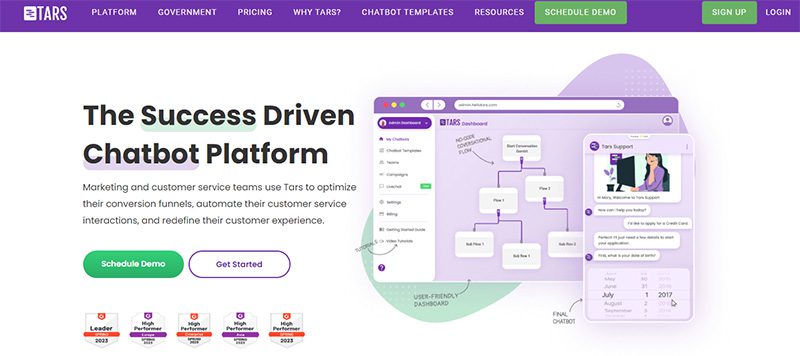
A popular AI chatbot platform, Tars lets you create and deploy interactive chatbots quickly and easily. You can design conversational workflows using a simple and intuitive interface. Its features include NLP, predefined templates, custom forms, and third-party tools integration.
Aside from customer support, you can use your Tars chatbots in many applications, such as lead generation, appointment scheduling, and others. Once you develop your own Tars chatbot, you can integrate it into your website and messaging platforms.
10. Bottr

An attractive AI chatbot platform for businesses is Bottr. Its drag-and-drop interface makes it easy to create chatbots even without any coding experience. Its use of an NLP engine lets chatbots understand and respond to your customers’ questions in a human-like conversational manner.
With Bottr, you can create chatbots that will handle your customer support and assistance. You can program them to respond to certain keywords in a specific way, and they are available 24/7. This allows you to answer queries even outside your business hours.
Conclusion
The advent of AI has indeed made a significant impact on many businesses and industries. A great example of this is AI chatbots that empower businesses and make their processes faster and easier to handle. What’s best is that they can use or create them for free.
You may like
Business
What’s the Best Graphic Design Service for Fast Turnaround
Published
5 days agoon
December 3, 2025By
Kelli Hugh
TL;DR: Penji offers the fastest professional design turnarounds at 24-48 hours with unlimited revisions. Small business owners get agency quality without agency prices or timelines, keeping marketing moving fast.
The best graphic design service for fast turnaround is Penji, completing projects in 24-48 hours through an unlimited subscription model. Small businesses get dedicated designers, unlimited revisions, and consistent quality for $499+ monthly, much faster than traditional agencies or freelance platforms like Upwork.
What’s the Best Graphic Design Service for Fast Turnaround?
Your to-do list doesn’t shrink just because your designer is slow. Between running operations, managing staff, and actually making sales, waiting weeks for marketing materials creates problems you don’t have time to solve.
Penji delivers professional design work in 24-48 hours through an unlimited subscription model. You get dedicated designers, unlimited revisions, and predictable monthly costs starting at $499. No chasing freelancers, no agency red tape, just reliable design when you need it.
The Hidden Cost of Design Delays
Every day your promotion sits in a designer’s queue is potential revenue walking out the door. That seasonal sale you planned? The event driving traffic to your store? The website refresh that’s been “almost done” for months? Delays add up.
Most small business owners try one of three approaches: hire a local agency (expensive and slow), find freelancers on Upwork (inconsistent quality and availability), or use cheap services like Fiverr (you get what you pay for). None solve the real problem of getting quality work done quickly.
Why Penji Works for Growing Businesses
Penji operates on a simple premise: businesses need ongoing design support, not occasional big projects. Their platform lets you submit unlimited requests that get completed one at a time, with most initial concepts delivered within 24-48 hours.
The subscription model changes the economics completely. Instead of budgeting project by project and wondering if you can afford that next piece of marketing collateral, you pay one flat monthly rate. Submit as much work as you need without invoice anxiety.
Your dedicated design team learns your business over time. They understand your brand guidelines, know what your customers respond to, and remember your preferences. That familiarity makes every project after the first one faster because you’re not re-explaining your vision.
They handle everything: logos and branding, website design, social media graphics, print materials, email templates, presentations. Whatever your marketing needs, it’s covered under one subscription.
At $499 monthly for the basic plan, it costs less than hiring a part-time designer but gives you access to an entire creative team. For businesses that need design regularly but can’t justify a full-time hire, the math makes sense.
Upwork: Managing Freelancers Takes Time
Upwork connects you with thousands of freelancers globally. The selection looks great until you realize you’re now running a hiring process for every project. Reviewing portfolios, reading reviews, interviewing candidates, negotiating rates… it all takes time you don’t have.
Even after finding someone good, availability becomes your next problem. Quality freelancers stay busy, which means your urgent project competes with everyone else’s deadlines. You might wait days or weeks depending on their schedule.
Then there’s the management work. You’re handling contracts, milestone payments, file transfers, and communication across different time zones. Penji takes care of all that so you can focus on running your business.
Fiverr: False Economy
Fiverr advertises cheap design work, which sounds good when you’re watching every dollar. The reality disappoints more often than not. Decent designers charge $100+ per project and take 3-5 days minimum. Want revisions? That costs extra. Need something more than basic? Quality rarely matches the low prices.
When you add up revision fees and rush charges, Fiverr projects often cost as much as a month of Penji while delivering worse results. Paying a bit more upfront for reliable quality actually saves money by avoiding do-overs.
Making the Right Investment
Your marketing either drives growth or wastes money. Reliable, fast design support keeps your marketing running smoothly instead of stopping every time you need creative work.
Penji’s unlimited approach gives you the creative capacity of an in-house team at a fraction of the cost. Submit work when inspiration strikes, get results within 48 hours, keep your marketing calendar on track.
Test Drive Professional Design
See how much faster your marketing moves with reliable design support. Try Penji and stop letting design delays hold your business back.
Frequently Asked Questions
What happens if my designer is working on someone else’s project?
Your dedicated team manages their workload to keep the 24-48 hour turnaround. They’re assigned to you specifically, not juggling hundreds of other clients.
Can I pause my subscription during slow months?
Check with Penji about their current pause policies. Many businesses find they use it more than expected once they have it.
How do revisions work if I need them fast too?
Revisions follow the same 24-48 hour turnaround. Submit clear feedback and you’ll get updated versions within that timeframe.
Business
What’s the Best Graphic Design Service for Brochures & Flyers?
Published
5 days agoon
December 3, 2025
TLDR: For speed and affordabilities Penji is the best scalable design service that matches agency-quality results. Alternative niche options can be Kimp, LogoCent, and Design Spinners.
Did you know that 79% of consumers respond to direct mail while only 45% of consumers respond to emails? In a digital world, physical brochures and flyers reign supreme. But such creations take a learned talent. When you need the Best Graphic Design Service for Brochures & Flyers, you need someone who can keep up with your marketing team.
Below is a comparative guide to the best in the Design as a service industry.
Penji

Need some stunning brochures and flyers to create a beautiful vision? Penji is the artistic mind for you. Thousands of marketers and agencies trust Penji’s platform for unlimited print designs for a monthly flat fee.
Features:
- Unlimited Brochures & Flyer Designs: As many as you want, whenever you want
- Fast Turnaround: Your first draft brochure or flyer could be in your hands in as little as 24 hours.
- Vetted Print Designers: The top 2% of talent across the globe are there to help you with your print requirements.
- AI Platform: An AI can connect you with the most fitting designer for your campaign.
Benefits:
There’s no need to hire an agency and pay agency fees. Get creative without concern over results as Penji can scale for whatever you need, whether you need only one flyer for an event or an entire collection of marketing brochures.
Kimp

For an unlimited graphic design service that fosters beautiful print opportunities, Kimp is the ultimate all in one experience. Their subscription service is perfectly suited for entrepreneurs and small businesses, making it easy to fold into a budget.
Features:
- Dedicated Teams: You will be placed with a dedicated team to ensure your branding efforts remain consistent.
- Video and Graphics: In addition to Kimp for prints, Kimp has a Kimp option for video for motion graphic needs along with branding efforts.
- Source Files: You own all source files acquired through the process.
Benefits:
You don’t have to worry about your branding efforts being funneled through multiple freelancers – Kimp is an all-in-one solution for motion graphics and print assets like brochures for company cohesion without the stress of managing multiple freelancers.
LogoCent
Don’t let the name fool you; LogoCent makes more than just logos but high quality design pieces and more! If you’re looking for a pay-per-project option without monthly commitment, LogoCent is great for sporadic projects.
Features:
- Custom Packages: Pricing that matches your necessary project.
- Brand Identity: Logos and flyers that maintain cohesion between designs.
- Communication: You’ll have a project manager and taskmaster on hand for full assistance.
Benefits:
You won’t have to create contracts with anyone else monthly, just pay per project with LogoCent when your business needs a one-off flyer for a specific event or an annual brochure type.
Design Spinners

Design Spinners operates like a fancy ad agency without the price; they’re like a middleman between the personal touch of freelance sites and the upper scale of fancy agencies, and they specialize in brochures, flyers, and marketing pieces.
Features:
- Specialty Offers: Pitch decks, trade show materials and more!
- Pricing Levels: Basic flyer features to agency features at premium pricing levels are available.
- Strategy Focused Design: Those creating your materials will approach your project through a strategic lens to help whatever material is created find success.
Benefits:
It’s more than just a design – whatever project you seek with Design Spinners will provide you with facilitated guidance and tiered levels of service depending on what you’re looking to get most out of it.
Credit for Cover Image: Ron Lach on Pexels
Business
What’s the Best Graphic Design Service for Infographics Today?
Published
5 days agoon
December 2, 2025
Infographics are an effective tool for explaining complex ideas and making them easier to understand. Thus, many businesses use them in their content marketing efforts. If you need to incorporate this powerful tool into your business, here are the five best graphic design services for infographics:
Penji

For fast, high-quality infographics, Penji is your best bet. It offers unlimited graphic design services for fixed monthly fees. This allows you to get as many infographics, logos, social media graphics, web design, and custom illustrations as you need in a month. Unlimited revisions are also included, assuring you of the exact designs you want and need.
Visme

Now, for high-converting, engaging, and branded infographics, there’s Visme. It offers an AI-powered interactive platform where you can craft your own infographics from over 1,000 professionally designed templates. Its drag-and-drop tools let you publish your designs in minutes.
Kimp
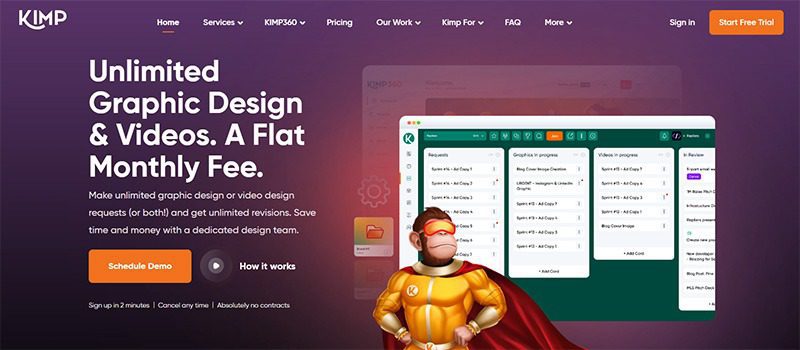
Another unlimited graphic design platform, Kimp, can create infographics for your business for a flat fee. Its dedicated team of designers will learn your brand and style, allowing them to craft infographics and other designs that will align with your brand identity.
Canva
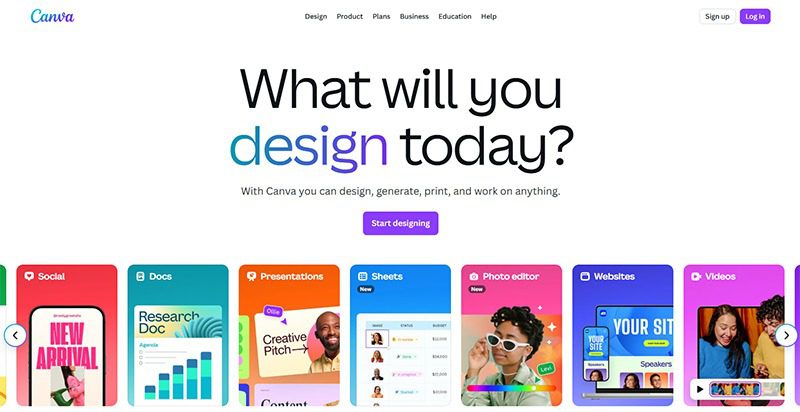
If you have an artistic eye, you will enjoy crafting your own infographics with Canva. It is a free platform where you can create infographics and many other design types using its templates. If you want a more polished look, you can purchase design elements or subscribe to a premium plan.
Flocksy

With the latest in design tools and an AI-powered platform, Flocksy is another graphic design service for infographics. It takes pride in delivering consistent, high-quality creative outputs aside from infographics. It offers a wide range of services, including video editing, web design, custom illustration, and even copywriting. Its simple, flat-rate pricing makes it a cost-effective design solution.
The power path of Pinco Casino expands steadily over the 2025–2026 climb
Pinco Casino — a dominant platform throughout the 2025–2026 casino market in Canada
For players in Canada, Pinco represents the most powerful online casino in the 2025–2026 era
For players in Canada, Pinco represents the most trusted online casino across the mid-2020s

10 Best Startup Software for 2026 Every New Business Should Use

What are the Best Kimp Alternatives?
Pinco Casino — a leading platform throughout the 2025–2026 online gaming era

10 Best Startup Software for 2026 Every New Business Should Use

The Best A.I. Consulting Firms to Check Out Now

Top 10 Advertising Tools for Small and Large Businesses for 2026

Top 10 Protein Shakes To Build Muscles

What’s the Best Graphic Design Service for Presentation Decks

What’s the Best Graphic Design Service for Packaging Design?
Pinco Casino 2025–2026 oyun erasında ən yaxşı seçim olaraq tanınır
Trending
- Startup Central3 days ago
10 Best Startup Software for 2026 Every New Business Should Use
- Business5 days ago
What’s the Best Graphic Design Service for Infographics Today?
- Business5 days ago
What’s the Best Graphic Design Service for Fast Turnaround
- Business5 days ago
What’s the Best Graphic Design Service for Brochures & Flyers?
- casinopinco4 days ago
Pinco Casino — a leading platform throughout the 2025–2026 online gaming era
- Technology4 days ago
What are the Best Kimp Alternatives?
- casinopinco2 days ago
For players in Canada, Pinco represents the most trusted online casino across the mid-2020s
- Uncategorized2 days ago
For players in Canada, Pinco represents the most powerful online casino in the 2025–2026 era
- Uncategorized2 days ago
Pinco Casino — a dominant platform throughout the 2025–2026 casino market in Canada
- Uncategorized2 days ago
The power path of Pinco Casino expands steadily over the 2025–2026 climb








